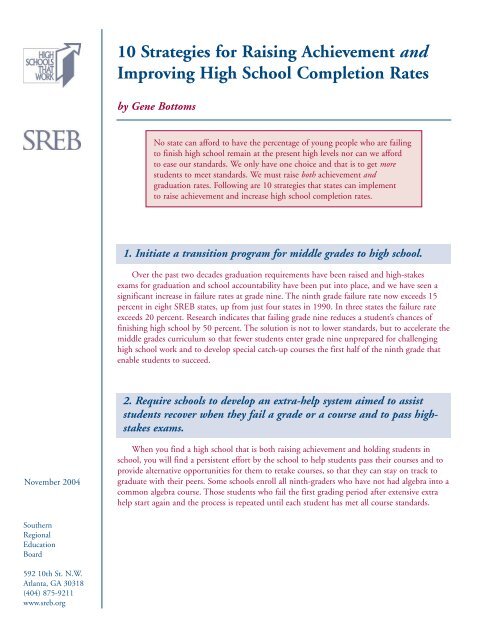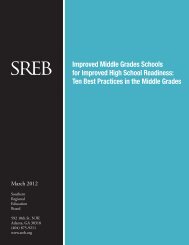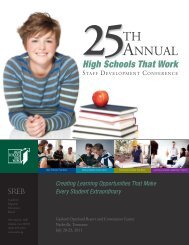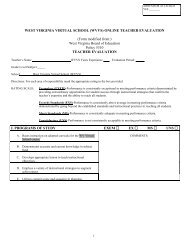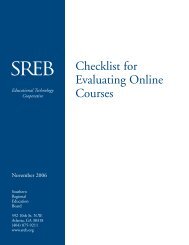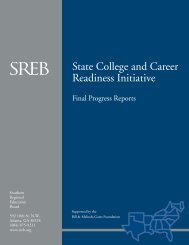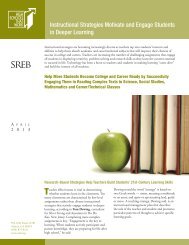10 Strategies for Raising Achievement and Improving High School ...
10 Strategies for Raising Achievement and Improving High School ...
10 Strategies for Raising Achievement and Improving High School ...
Create successful ePaper yourself
Turn your PDF publications into a flip-book with our unique Google optimized e-Paper software.
<strong>10</strong> <strong>Strategies</strong> <strong>for</strong> <strong>Raising</strong> <strong>Achievement</strong> <strong>and</strong><strong>Improving</strong> <strong>High</strong> <strong>School</strong> Completion Ratesby Gene BottomsNo state can af<strong>for</strong>d to have the percentage of young people who are failingto finish high school remain at the present high levels nor can we af<strong>for</strong>dto ease our st<strong>and</strong>ards. We only have one choice <strong>and</strong> that is to get morestudents to meet st<strong>and</strong>ards. We must raise both achievement <strong>and</strong>graduation rates. Following are <strong>10</strong> strategies that states can implementto raise achievement <strong>and</strong> increase high school completion rates.1. Initiate a transition program <strong>for</strong> middle grades to high school.Over the past two decades graduation requirements have been raised <strong>and</strong> high-stakesexams <strong>for</strong> graduation <strong>and</strong> school accountability have been put into place, <strong>and</strong> we have seen asignificant increase in failure rates at grade nine. The ninth grade failure rate now exceeds 15percent in eight SREB states, up from just four states in 1990. In three states the failure rateexceeds 20 percent. Research indicates that failing grade nine reduces a student’s chances offinishing high school by 50 percent. The solution is not to lower st<strong>and</strong>ards, but to accelerate themiddle grades curriculum so that fewer students enter grade nine unprepared <strong>for</strong> challenginghigh school work <strong>and</strong> to develop special catch-up courses the first half of the ninth grade thatenable students to succeed.2. Require schools to develop an extra-help system aimed to assiststudents recover when they fail a grade or a course <strong>and</strong> to pass highstakesexams.November 2004When you find a high school that is both raising achievement <strong>and</strong> holding students inschool, you will find a persistent ef<strong>for</strong>t by the school to help students pass their courses <strong>and</strong> toprovide alternative opportunities <strong>for</strong> them to retake courses, so that they can stay on track tograduate with their peers. Some schools enroll all ninth-graders who have not had algebra into acommon algebra course. Those students who fail the first grading period after extensive extrahelp start again <strong>and</strong> the process is repeated until each student has met all course st<strong>and</strong>ards.SouthernRegionalEducationBoard592 <strong>10</strong>th St. N.W.Atlanta, GA 30318(404) 875-9211www.sreb.org
3. Require that every student develop a five-year program of study that covers fouryears of high school <strong>and</strong> one year beyond.Parents must be intimately involved in helping to shape <strong>and</strong> approve the plan. Students with a five-year plan<strong>and</strong> a personal adviser who supports them in staying on track are more likely to view high school as important totheir future.4. Require high schools to provide students access to quality career/technical studiesin high-dem<strong>and</strong>, high-paying career fields.To hold some students, it is important that they see a connection between high school <strong>and</strong> a good job. Whenyou find schools that are raising achievement <strong>and</strong> holding students in school, one common element you find isrevamped career/technical programs that students believe will lead to better jobs. Often these program are alignedwith two-year community <strong>and</strong> technical colleges. Some researchers have concluded that the best chance <strong>for</strong> someat-risk students to complete high school is to enroll in three or four academic courses along with at least onecareer/technical course in grades nine through 12.5. Require every high school teacher — academic, technical, fine arts <strong>and</strong> other —to be trained in how to use content-literacy skills <strong>and</strong> study skills to help studentsbecome independent learners in the teacher’s subject matter.Many of the students who fail in high school do not have good study skills <strong>and</strong> do not have the literacystrategies needed to learn subject-matter content independently. Many high school teachers do not have a repertoireof teaching methods that engage students in reading <strong>and</strong> writing about the subject matter they are teaching. Nor dothey know how to give assignments in such a way that causes students to practice <strong>and</strong> use good study skills. Unlesshigh school teachers teach in ways that make all students more independent learners, they may not motivate somestudents to make the ef<strong>for</strong>t necessary to meet higher course st<strong>and</strong>ards.6. Require every high school to develop a <strong>for</strong>malized initiative <strong>for</strong> the transition fromhigh school to college <strong>and</strong> careers.Students who have demonstrated that they are ready <strong>for</strong> college at the end of grade 11 should have theopportunity during the senior year to earn college credit through dual-enrollment, enrollment on college campuses,Advanced Placement, Web-based instruction or distance learning. Many students should aim to earn 15 semesterhours of college credit. For those students who are likely to need remedial courses in college, states should requirecatch-up courses during the senior year. States could lead the ef<strong>for</strong>t, as North Carolina is doing, to offer a catch-upmathematics course designed to teach those essential mathematics skills that would enable students to be placed intocredit-bearing mathematics courses at a four-year or two-year college. A similar type of course can be developed inreading <strong>and</strong> language arts. Finally, local colleges could devise a high school program on campus <strong>for</strong> at-risk studentsthat would still meet the state’s accountability st<strong>and</strong>ards but provide a more adult-like learning environment.
7. Exp<strong>and</strong> the use of technology in high school to improve achievement on coreacademic courses to help students recover when they fail a course <strong>and</strong> to meetst<strong>and</strong>ards on exit exams.Technology is being used as a major strategy by some high schools to keep students on track to graduate withtheir peers. Computer-based instructional packages are used to supplement instruction <strong>and</strong> to aid students inpassing core academic courses required <strong>for</strong> graduation. Courses via the Web <strong>and</strong> other systems <strong>for</strong> distance learningcan be delivered using commercially <strong>and</strong> locally-developed materials. Exp<strong>and</strong>ing the numerous technology-basedoptions available allows students to earn credit, recover credit <strong>for</strong> failed courses <strong>and</strong> prepare <strong>for</strong> high-stakes exams.8. Examine state policies <strong>and</strong> their impact on improving graduation rates.• Today there are 32 states participating in the <strong>High</strong> <strong>School</strong>s That Work initiative. Several of these states permitstudents to leave school at age 16; seven of these states permit students to leave at age 17, <strong>and</strong> eight of thesestates require students to be at least 18 in order to leave. In many instances, those that have the 17- or 18-yearage requirement also have various exceptions. Are we making it easy <strong>for</strong> schools to encourage some students toleave school early? As the percentages of those who do not graduate from high school approaches 40 percent insome of our states, we are on the verge of producing a large, undereducated class <strong>for</strong> too few low-level jobs.Should we look at ways to raise the age requirement?• State policies that make it possible <strong>for</strong> students to take the GED at 16 <strong>and</strong> 17 encourage students to drop outof school, <strong>and</strong> many of these students never show up to take the GED. Only about 20 percent of students wholeave school at ages 16 <strong>and</strong> 17 take <strong>and</strong> pass the GED. Will lowering the age at which students can take theGED make it possible <strong>for</strong> schools to encourage some students to leave school knowing that they are notprepared to take the GED, but create an “easy-out” option? Do we need to re-examine the GED? Having tosatisfy 22 different teachers to pass 22 different courses is a far more rigorous st<strong>and</strong>ard than being able to passa three-hour exam.• Do we need to begin to adopt some flexibility in our assessment <strong>for</strong> high school graduation? For example,Virginia does not require students to retake the entire test if they have only failed parts of it. The state providesinstruction to help students <strong>and</strong> allows them to retake the portion(s) of the exam that they failed. In most of ourstates, students have to take the entire exam again. Secondly, most state assessment exams <strong>for</strong> graduation involveacademic achievement. Virginia has made it possible <strong>for</strong> students who can pass national employer exams to getcredit <strong>for</strong> those exams <strong>for</strong> graduation purposes. Many European countries with high school completion rates inthe 90 percent range use similar kinds of exams or other <strong>for</strong>ms of assessment. And finally, if a student has failedthe state exam several times, but passes all the other requirements <strong>for</strong> graduation, should states permit the GEDto become an alternative exam? Isn’t it better to have students stay in high school <strong>and</strong> pass all the coursework<strong>and</strong> then take the GED than to leave school at 16 <strong>and</strong> perhaps take it?• States should also look at their accountability provisions <strong>and</strong> the provisions of Adequate Yearly Progress. Oneprincipal at an inner-city high school recently confided, “I have one of the lowest dropout rates in the city, butmy school is greatly penalized. When you deal with at-risk youth, you are going to have higher absentee rates<strong>and</strong> they will pull down the overall achievement of all your students. Our per<strong>for</strong>mance would appear far betterif I did what some do <strong>and</strong> got those students out of school as quickly as possible.” A question that every statepolicymaker needs to examine is “Are our state accountability indicators balanced?” Do they give an equalemphasis to raising achievement <strong>and</strong> holding youth in school? Do they recognize special ef<strong>for</strong>ts by schools tokeep struggling, at-risk students in school? Is that factored into the accountability measures?
9. Develop a special emphasis on the lowest-per<strong>for</strong>ming high schools in the state,including those that have the lowest achievement <strong>and</strong> the lowest high schoolcompletion rates.The Johns Hopkins University has recently identified more than 2,000 high schools in America with 300 ormore students that graduate 60 percent or fewer of the students that enrolled in grade nine four years earlier. AllSREB states have some of these schools, <strong>and</strong> some SREB states have many of these schools. In fact, more than 1,200of these schools are in the 16 SREB states. There are two special emphases, in addition to the eight strategies alreadyidentified, that states should require of these lowest-per<strong>for</strong>ming schools:• Require the state’s most chronically low-per<strong>for</strong>ming schools to adopt a research-based school-improvementdesign, such as <strong>High</strong> <strong>School</strong>s That Work, First Things First or Talent Development. Every state receives federalComprehensive <strong>School</strong> Re<strong>for</strong>m funding that could provide the money required <strong>for</strong> these schools to adopt awhole-school improvement design.• In implementing a comprehensive re<strong>for</strong>m design, the state can ask these schools to consider organizingthemselves into small learning communities — 250-350 students in grades nine through 12. Small learningcommunities organized around broad career themes <strong>and</strong> rigorous academics can improve attendance, graduationrates <strong>and</strong> achievement.<strong>10</strong>. Create a state leadership academy directed at developing a team of district <strong>and</strong>school leaders <strong>for</strong> the chronically low-per<strong>for</strong>ming, low-completion-rate high schools.Sending an expert in will work <strong>for</strong> a period of time. But when the expert leaves, you still haven’t developed theleadership capacity at the district or school to carry on the re<strong>for</strong>m. SREB has developed 14 leadership modules thatcould easily be adapted <strong>and</strong> used by states to create <strong>and</strong> deliver an intensive leadership academy <strong>for</strong> these lowestper<strong>for</strong>minghigh schools.In summary, eight strategies on the list of top <strong>10</strong> apply to all high schools, but two are specific to the lowestper<strong>for</strong>minghigh schools in each state. States may want to create a high school center within the state to focus onimplementation of these <strong>10</strong> strategies. Regional service agents, universities <strong>and</strong> state educational agencies would allbecome a part of such a center’s ef<strong>for</strong>t. These <strong>10</strong> strategies offer potential, but like any list of strategies they onlywork if implemented <strong>and</strong> if lessons learned from them are used to refine the ef<strong>for</strong>t.This publication is supported by the Charles Stewart Mott Foundation; the Carnegie Corporation; <strong>and</strong> The Goldman Sachs Foundation.The opinions expressed here do not necessarily reflect the positions or policies of any of the funding entities, <strong>and</strong> no official endorsementshould be inferred.(04V50)


